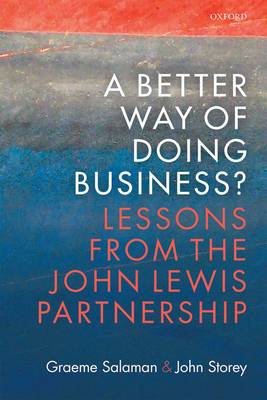
- Afhalen na 1 uur in een winkel met voorraad
- Gratis thuislevering in België vanaf € 30
- Ruim aanbod met 7 miljoen producten
- Afhalen na 1 uur in een winkel met voorraad
- Gratis thuislevering in België vanaf € 30
- Ruim aanbod met 7 miljoen producten
Zoeken
A Better Way of Doing Business?
Lessons from The John Lewis Partnership
Graeme Salaman
Hardcover | Engels
€ 52,45
+ 104 punten
Omschrijving
This book offers a thoroughly researched and accessibly written account of the John Lewis Partnership. It describes what the JLP is, how it works, and what other businesses can learn from it. The US/UK model of the firm, with its emphasis on shareholder value and its openness to the market in the buying and selling of businesses, is prone to a number of problematic consequences for employees, suppliers, and sometimes share-holders. The JLP represents a contrast to this model - one that has implications beyond the small niche of mutually-owned firms. The JLP has lessons for organizations that are unlikely to move towards the Partnership's distinctive shared ownership. This book identifies these lessons. The key questions addressed include: how does the JLP work in practice? What is the link between co-ownership, the JLP employment model, and the performance of the businesses? What is the role of management in the success of John Lewis and Waitrose? Are mutuality, co-ownership and business performance at odds? What is the significance of democracy within the JLP? And probably most significantly: what are the implications, for policy-makers and for economic agents of the JLP? This book is based on detailed knowledge of the JLP and its constituent business gathered by the authors over a fifteen year period. Their conclusion: that the JLP is more complex, even more impressive, and more interesting than its admirers realise.
Specificaties
Betrokkenen
- Auteur(s):
- Uitgeverij:
Inhoud
- Aantal bladzijden:
- 250
- Taal:
- Engels
Eigenschappen
- Productcode (EAN):
- 9780198782827
- Verschijningsdatum:
- 5/10/2016
- Uitvoering:
- Hardcover
- Formaat:
- Genaaid
- Afmetingen:
- 152 mm x 231 mm
- Gewicht:
- 430 g

Alleen bij Standaard Boekhandel
+ 104 punten op je klantenkaart van Standaard Boekhandel
Beoordelingen
We publiceren alleen reviews die voldoen aan de voorwaarden voor reviews. Bekijk onze voorwaarden voor reviews.








